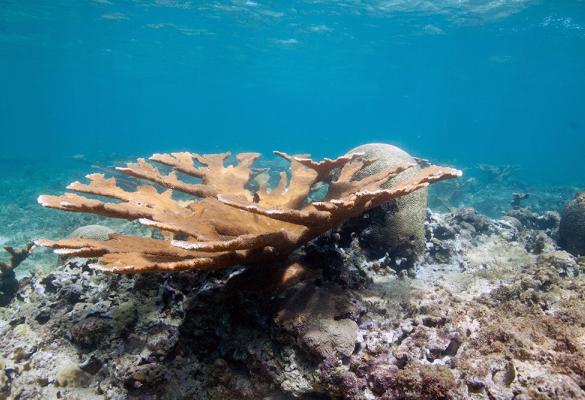Coral Reef Restoration
Coral reefs are the skeletons of marine invertebrates called coral, which form large underwater structures comprised of colonies. Coral reefs are built by hard corals that extract calcium carbonate from the ocean to create an exoskeleton (Ross 2018). Coral polyps, which are individual corals, begin building reefs by attaching themselves to submerged rocks or hard surfaces near the ocean floor (CRA 2018). In most cases, coral reefs are constrained to shallow waters and latitudes between 30° north and south of the equator (NOS n.d.). In the United States, corals are concentrated in the Pacific Islands, the Caribbean, and the Gulf Coast, with a few isolated deep-sea corals off the Pacific and Carolina coasts (Necaise et al. 2022; Oceana n.d.). Coral reefs are sensitive ecosystems facing many threats, including ocean acidification, increases in water temperatures, pollution, and physical damage (EPA 2023). Coral reef restoration strategies include direct transplantation, coral gardening, invasive species removal, micro-fragmentation and building artificial reefs (Boström-Einarsson et al. 2020).

Case Studies
A Community Effort Stems Runoff to Safeguard Corals in Puerto Rico
Molasses Coral Reef Restoration Project
Post-Disaster Coral Reef Assessment & Restoration Set Important Precedent for Coastal Communities
Tools
A Manager's Guide to Coral Reef Restoration, Planning and Design
Caribbean Acropora Restoration Guide: Best Practices for Propagation and Population Enhancement
Coral Reef Restoration Monitoring Guide
Coral Reef Restoration for Risk Reduction (CR4): A Guide to Project Design and Proposal Development
Coral Reef Restoration for Risk Reduction (CR4): Guide to Project Design and Proposal Development
Coral Reef Restoration: The Rehabilitation of an Ecosystem Under Siege
Green Infrastructure Effectiveness Database
Green Infrastructure for Coral Conservation
Handbook on Coral Reef Impacts: Avoidance, Minimization, Compensatory Mitigation, and Restoration
Hawaii Division of Aquatic Resources Coral Restoration Implementation Guide
Promoting Nature-Based Hazard Mitigation Through FEMA Mitigation Grants
Research Needs for Coastal Green Infrastructure
Training Guide for Coral Reef Restoration
Use of Natural and Nature-based Features (NNBF) for Coastal Resilience
Using Nature-Based Solutions Across Landscapes (Infographic)
Likely Benefits and Outcomes
This strategy is likely to achieve these project goals. Click to search for strategies with a similar benefit.
Related Green (natured-based) vs. Gray infrastructure
In development.
